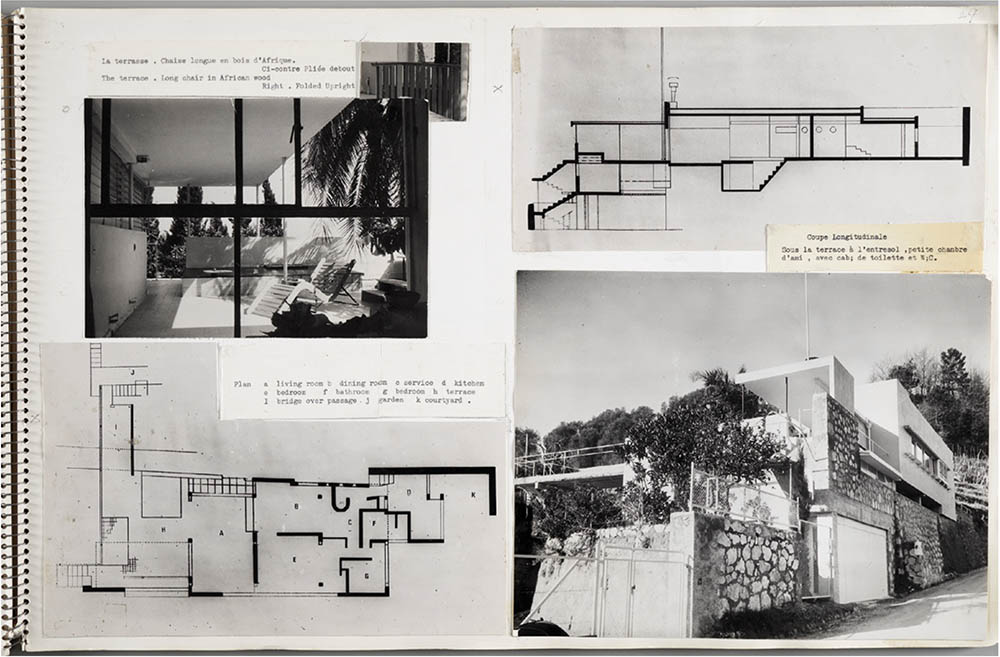Tempe à Pailla (1931-1935) in Castellar by Eileen Gray
Downloads
DOI:
https://doi.org/10.52200/docomomo.73.01Keywords:
Eillen Gray, modern movement, maison minimum, spatial flexibility, modern interiorAbstract
Petite Maison dans les Environs de Castellar: this is how Eileen Gray (1878-1976), a designer active in early 20th-century France, entitled in her cahiers the architecture she built between 1931 and 1935. The villa, later named Tempe à Pailla, is an opportunity to deepen her research on that intense dialog between interior and exterior, between domestic space and natural environment, already experimented with Jean Badovici (1893-1956) in the villa E1027 (1926-1929) in Roquebrune-Cap-Martin.
According to Eileen Gray’s definition, a house is not a machine à habiter but ‘the shell of man, his extension, his release, his spiritual emanation.’ The theme of spatial flexibility is approached through the design of mechanical moving components that rotate or slide, unfold, and contract, thanks to the possibilities of new materials, in a mechanical ballet that expands the narrow dimension of a maison minimum into a dwelling with a greater width. These solutions are intended to negate the facade as a frontier line between the architectural space and the close surroundings; any hierarchical relationship between furniture, interiors, architecture, and site is denied. The kinaesthetic aspect in Tempe à Pailla is absolute, since the house lives of the relationship between the movement of architectural components and the experiential dimension of the human body in domestic space, all in relation to the surrounding natural environment. This article aims to demonstrate how Eileen Gray’s innovative theoretical framework, exemplified by villa Tempe à Pailla, offers valuable lessons for addressing contemporary challenges. In this context, it highlights the design solutions adopted by the architect to ensure the well-being of inhabitants, even within minimal spaces, emphasizing the importance of transitional spaces between built and natural environments, thereby expanding the notion of the interior. At the same time, it becomes an opportunity to explore how a renewed relationship with nature can offer meaningful insights for contemporary architectural practices, which now more than ever require particular attention to environmental issues.
How to Cite
Published
Issue
Section
License
Copyright (c) 2025 Vittoria Bonini

This work is licensed under a Creative Commons Attribution 4.0 International License.
Plaudit
References
ADAM, P., & Gray, E. (2019). Eileen Gray: Her life and work. Thames & Hudson.
ADAM, P., & Gray, E. (2000). Eileen Gray: Architect/designer. Thames & Hudson.
BADOVICI, J. (1924). L’art d’Eileen Gray [The Art of Eileen Gray]. Wendingen, 6, 12-15.
BADOVICI, J., & Gray, E. (1924). Entretiens sur l’Architecture Vivante. Eileen Gray [Conversations on Living Architecture. Eileen Gray]. L’Architecture Vivante, Automne-Hiver.
BADOVICI, J., & Gray, E. (1930). La Maison Minimum [The Minimum House]. L’Architecture d’Aujourd’hui, 1, 30.
BENTON, T. (2022). Cap moderne: Eileen Gray and Le Corbusier, modernism by the sea (New ed). Éditions du Patrimoine, Centre des monuments nationaux.
BONINI, V. (2023). Una cinematica della soglia. Tecnica e modernità nella poetica di Eileen Gray, [A Kinematics of the Threshold. Technique and modernity in the poetics of Eileen Gray], PhD Thesis, Università di Genova, Dipartimento di Architettura e Design. https://hdl.handle.net/11567/1119195
BONINI, V., & Morbiducci, R. (2024). The Climate Issue in Modern Architecture: Eileen Gray’s Tempe à Pailla Villa (1931-1935). In R. Corrao, T. Campisi, S. Colajanni, M. Saeli, & C. Vinci (Eds.), Architectural Engineering in Italy and Worldwide. Comparing experiences. Book of Abstract (p. 40). Edicom Edizioni. DOI: https://doi.org/10.1007/978-3-031-71855-7_7
CONSTANT, C. (1994). E. 1027: The Non-Heroic Modernism of Eileen Gray. Journal of the Society of Architectural Historians, 53(3), 265–279. DOI: https://doi.org/10.2307/990937
CONSTANT, C. (2020). K9 Tempe à Pailla, Castellar 1931-1935. In C. Pitiot, N. Stritzler-Levine, Bard Graduate Center: Decorative Arts, Design History, Material Culture, & Centre Georges Pompidou (Eds.), Eileen Gray (pp. 390–391). Bard Graduate Center.
FRAMPTON, K. (2021). The other modern movement: Architecture, 1920-1970. Yale University Press.
GOFF, J. (2015). Eileen Gray: Her work and her world. Irish Academic Press.
GOFF, J., & Constant, C. (2020). Tempe a Pailla: Working Independently. In C. Pitiot & N. Stritzler-Levine (Eds.), Eileen Gray (pp. 221–234). Bard College Center.
GRAY, E., & Badovici, J. (1929). De l’éclectisme au doute [From Eclecticism to Doubt]. L’Architecture Vivante, Automne Hiver.
GRAY, E., Badovici, J., Rayon, J.-P., Bonillo, J.-L., & Gatier, P.-A. (2015). E 1027: Maison en bord de mer (Reproduction en fac-similé) [E 1027: House by the Sea]. Éditions Imbernon.
HECKER, S., Müller, C. F., & Gray, E. (1996). Eileen Gray (2. ed. español-inglés). Gili.
LE CORBUSIER. (1927). Ou en est l’architecture [Where Is Architecture Now?]. L’Architecture Vivante, Automne-Hiver.
LE CORBUSIER. (2017). Verso una architettura [Towards an Architecture]. P. Cerri & P. Nicolin, A c. Di; 14. ed. Longanesi.
LE CORBUSIER, & Benton, T. (2015). Precisions on the present state of architecture and city planning (Reprint of the original American edition, MIT Press, 1991). Park Books.
PITIOT, C., Barrès, R., & Benton, T. (2017). Eileen Gray, Une architecture de l’intime: Exposition, Paris, Centre Pompidou, 20 juin-31 octobre 2017 [Eileen Gray, An Architecture of Intimacy: Exhibition, Paris, Centre Pompidou, June 20 - October 31, 2017]. Cap moderne Éditions HYX Éditions du Centre Pompidou.
RAYON, J.-P. (2015). An (other) modern villa. In E 1027: Maison en bord de mer (Reproduction en fac-similé, pp. 112–117). Éditions Imbernon.
RYKWERT, J. (1971). Eileen Gray: Two Houses and an Interior, 1926-33. Perspecta, 13/14, 66–73. DOI: https://doi.org/10.2307/1566971
WILSON, C. S. J. (1995). The other tradition of modern architecture: The uncompleted project. Academy Editions.





